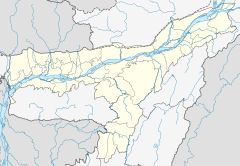This article has multiple issues. Please help improve it or discuss these issues on the talk page. (Learn how and when to remove these messages)
|
| Goreswar massacre | |
|---|---|
 | |
| Location | Goreswar, Kamrup district (now Baksa district), Assam, India |
| Date | 3 July 1960 (UTC+5:30) |
| Target | Bengali Hindus |
| Attack type | Massacre, ethnic cleansing, pogrom |
| Weapons | Guns, spears, swords, scythes, bows and arrows |
| Deaths | At least 9 men and 1 woman |
| Injured | More than 1,000 50,000 people fled to West Bengal |
| Perpetrators | Assamese mobs |
The Goreswar massacre was the massacre of Bengali Hindus in Goreswar, in the Kamrup district (now Baksa district) of the Indian state of Assam. The massacre was part of a pre-planned pogrom, organized in a meeting of the local Teachers' Association.
Background
During and after the independence of India movement, Bengali Hindus were ethnically cleansed in the Indian state of Assam. After the partition riots, the next major ethnic conflagration in Assam occurred during the Bengali language movement in 1960. The Government of Assam decided to make Assamese the only official language in the state. Bengali people protested against this decision as it would affect their employment prospects. The Barak Valley was a Bengali dominated area and became a centre of agitation. This in turn resulted in a spate of police shootings. In the Brahmaputra Valley, an Assamese-dominated area, Assamese mobs started attacking Bengalis.
Pogrom
Planning
A report claims that there was a secret meeting in early July 1960, at a school in Sibsagar. This was said to have been organized by the Teachers' Association. During the meeting, the massacre was planned as an attack on the Bengalis. The next day a students' strike was organised at Sibsagar and groups of students and youths were sent to Jorhat, Dibrugarh and other adjoining areas to communicate the decision of the meeting.
Massacre
On 14 July 1960, riots began in Sibsagar with the looting of Bengali shops and assaults on several Bengalis. In lower Assam (Kamrup, Nowgong and Goalpara) intense violence occurred in 25 villages in Goreswar (in Kamrup district). On 3 July an Assamese mob of 15,000, armed with guns and other weapons, raided Bengali shops and houses. The whole area was ransacked. According to an inquiry commissioned under Justice Gopalji Mahotra, 4,019 huts and 58 houses were vandalized or destroyed. The commission reported that at least nine Bengalis were killed and more were wounded or crippled. There is also a report that one woman was attacked and raped. Nearly 1,000 Bengali Hindus fled from the area during the riot.
Aftermath
| Cumulative refugee figures from Assam in Jalpaiguri district, West Bengal | |||||||
| Date | Cumulative figures | ||||||
|---|---|---|---|---|---|---|---|
| 16 July 1960 | 9,365 | ||||||
| 1 August 1960 | 18,340 | ||||||
| 21 August 1960 | 28,383 | ||||||
| 25 August 1960 | c. 50,000 | ||||||
The worst phase of violence occurred between July and September 1960. Nearly 50,000 Bengali Hindus had crossed over to West Bengal to seek shelter by late August 1960. Chief Minister of West Bengal, Dr. B. C. Roy wrote a letter to the Prime Minister of India about the violence. According to his letter, at least 4,000 Bengali Hindus had been displaced to West Bengal between 5 and 11 July as a result of the riots, and 447 others who may not have been fleeing the riot. After 31 July the flow of refugees increased. In a subsequent letter, Roy wrote that 45,000 displaced Bengalis had taken shelter in West Bengal.
See also
References
- Sharma, Suresh K. (2006). Documents on North-East India: Assam (1958 to modern times). Mittal Publications. ISBN 9788183240918.
- ^ Banerjee, Paula; Chaudhury, Sabyasachi Basu Ray; Das, Samir Kumar (2005-01-07). Internal Displacement in South Asia: The Relevance of the UN's Guiding Principles. SAGE Publications India. ISBN 9788132101987.
- Sharma, Suresh Kant; Sharma, Usha (2015). Discovery of North-East India. Mittal Publications. ISBN 9788183240390.
- Bhaumik, Subir (10 December 2009). Troubled Periphery: The Crisis of India's North East. SAGE Publishing India. ISBN 9789352801817. Retrieved 22 October 2018.
- Dutta, Uddipan (31 December 2012). "Chapter 4: Communal Riots on Language Issues" (PDF). The Role of Language Management and Language Conflict in the Transition of Post Colonial Assamese Identity (PhD). Gauhati University. p. 98-99. Retrieved 22 October 2018.
| Persecution of Bengali Hindus in Assam | |
|---|---|
| Perpetrators | |
| Issues | |
| Massacres | |
Categories:
- 21st-century mass murder in India
- 1960 riots
- July 1960 events in Asia
- 1960s in Assam
- 1960 murders in India
- Massacres in 1960
- Massacres of Bengali Hindus in Assam
- Anti-Hindu riots in India
- Ethnic cleansing in Asia
- Pogroms
- Baksa district
- History of the Kamrup region
- Looting in India
- Attacks on shops in India
- Attacks on buildings and structures in 1960
- Mass stabbings in India
- Sword attacks in India
- Rape in India
- Rape in the 1960s